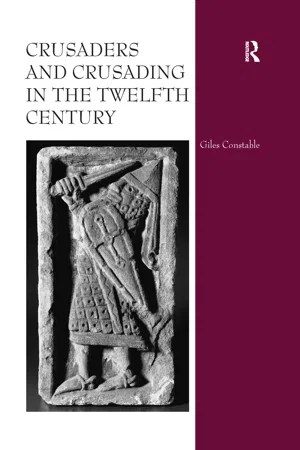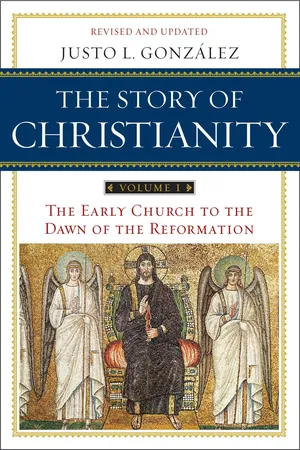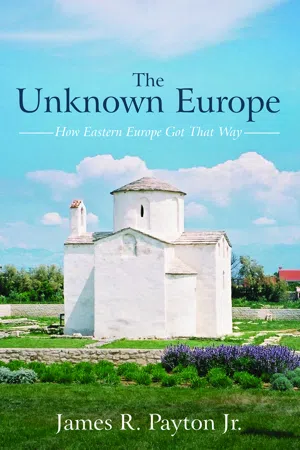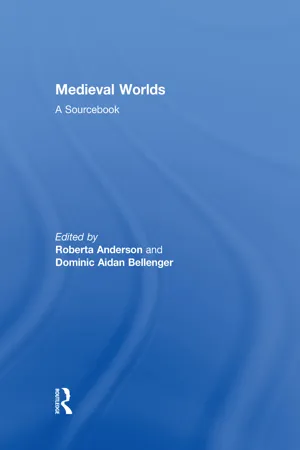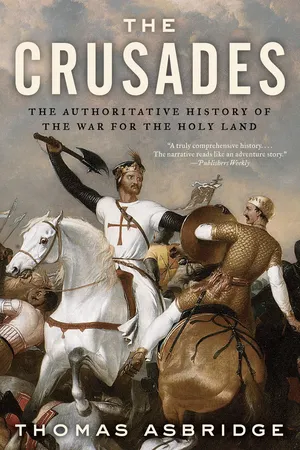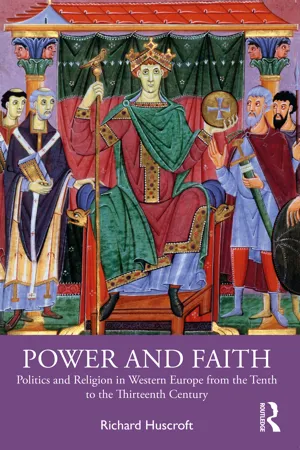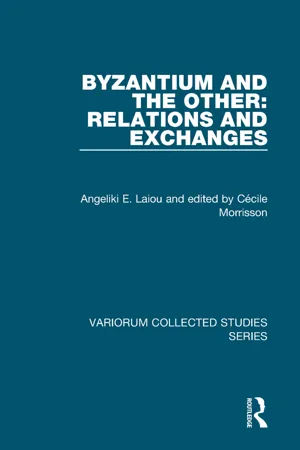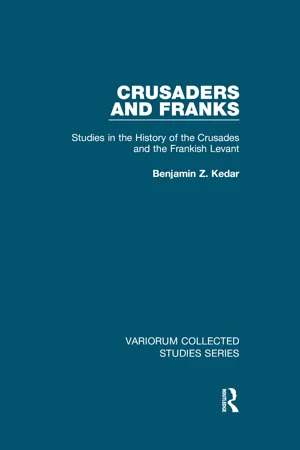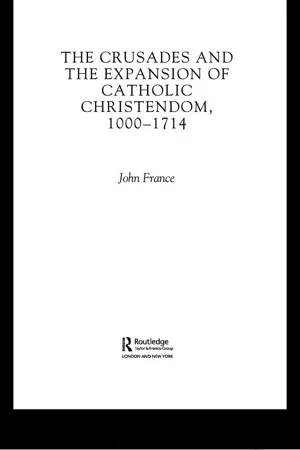History
Fourth Crusade
The Fourth Crusade was a military campaign initiated by Pope Innocent III in 1202 with the goal of recapturing Jerusalem from Muslim control. However, the crusaders ended up sacking the Christian city of Constantinople in 1204, leading to the weakening of the Byzantine Empire. This diversion from its original purpose had significant political and religious repercussions in the medieval world.
Written by Perlego with AI-assistance
Related key terms
10 Key excerpts on "Fourth Crusade"
- eBook - ePub
- Giles Constable(Author)
- 2016(Publication Date)
- Routledge(Publisher)
Chapter 13 The Fourth CrusadeThe crusades have a bad name today, and none of them worse than the Fourth Crusade, of which the eight hundredth anniversary was commemorated in 2004. Most scholars have little or nothing good to say about the expedition that was diverted or, in the opinion of many, perverted from its original goals in Egypt and the Holy Land and culminated with the capture and sack of Constantinople. ‘There was never a greater crime against humanity than the Fourth Crusade,’ said Steven Runciman in 1954, and subsequent writers have echoed his words, calling the crusade ‘ungodly’, ‘unholy’, ‘obviously criminal’, and ‘the ultimate perversion of the crusading idea’.1 It has caste a dark shadow not only over the participants, to whom some historians would deny the name of crusaders, but also over its promoters, including Innocent III, who has been compared to Stalin.2 Jane Sayers in her biography of Innocent called the crusade ‘an unqualified and dreadful disaster’ with an ‘ignominious and shameful outcome’.3This negative view of the Fourth Crusade is in part owing to the nature of the sources, which tell us in some respects too much (if that is possible) and in other respects too little about the undertaking.4 For the most part they go up to, but not beyond, the conquest of Constantinople, and pay little attention to the subsequent events. Geoffrey of Villehardouin and Robert of Clari, who were both participants, give detailed, though not entirely compatible, accounts of the external events. They were the first secular, and among the first vernacular, historians of the crusades. Their works were designed to be read aloud to noble audiences, and they each had a distinctive point of view and, to some extent, an axe to grind.5 The letters of Innocent III and the Deeds of Innocent III , written about 1208, manifestly present the papal position.6 Gunther of Pairis, like many of the minor sources published by Paul Riant in his Exuviae sacrae Constantinopolitanae , is primarily concerned with the relics taken by the crusaders from Constantinople to the west.7 In these Latin sources, the capture and sack of Constantinople was the real end of the crusade. The Greek historians Choniates and Mesarites likewise concentrate on the events in and around Constantinople.8 If there were similarly detailed accounts of the capture of Jerusalem in 1099, the prevailing view of the first crusade might be more like that of the fourth. ‘As “a crime against humanity”,’ Michael Angold wrote, ‘the conquest of Constantinople hardly rates beside the crusader sack of Jerusalem in 1099 or the excesses of the Albigensian crusade’9 - eBook - ePub
The Story of Christianity: Volume 1
The Early Church to the Dawn of the Reformation
- Justo L. Gonzalez(Author)
- 2014(Publication Date)
- HarperOne(Publisher)
The news shook Christendom, and Pope Clement III called for a renewal of the crusading enterprise. This Third Crusade was led by three sovereigns: Emperor Frederick Barbarossa, Richard the Lionhearted of England, and Philip II Augustus of France. This too failed. Frederick drowned, and his army dissolved. Richard and Philip achieved nothing but taking Acre after a siege that lasted two years. Philip then returned to Europe, hoping to take advantage of Richard’s absence to take some of the latter’s lands. Richard himself, on his way home, was captured by the emperor of Germany and kept a prisoner until an enormous ransom was promised.The Fourth Crusade, called by Innocent III, was an even greater disaster. Its goal was to attack Saladin at his headquarters in Egypt. A famous preacher, Foulques de Neuilly, was entrusted with the task of raising armies and funds for the Crusade. Foulques was a radical opponent of usury and all forms of social injustice who was incensed at the manner in which the developing monetary economy allowed the rich to use their money to become even richer, while the poor remained in poverty. In preaching the Crusade, Foulques declared that the poor were elected by God to fulfill this great task. All could participate in this project. Those who could not go on Crusade, no matter how poor, should support others who could. The rich must also join, for in so doing their exploitations were forgiven. Thus an army was raised eager to attack Saladin in his own capital.But, unbeknownst to Foulques and even to Pope Innocent, there were other plans afoot. The throne in Constantinople was disputed by two rivals, one of whom asked Innocent to send the Crusade first to Constantinople to place him on the throne. In exchange, he would then support the Crusade against Saladin. Innocent refused, but the Venetians, whose fleet was charged with the task of transporting the crusaders to Egypt, agreed to take them instead to Constantinople in exchange for large sums of money. Thus, the Crusade was rerouted to Constantinople, which the crusaders took. They then named Baldwin of Flanders emperor of Constantinople, and thus was founded the Latin Empire of Constantinople (1204–1261). A Latin patriarch of Constantinople was also named, and thus, in theory at least, East and West were reunited. Innocent III, at first incensed by this misuse of the Crusade, eventually decided that it was God’s way of reuniting the church. But the Byzantines did not accept matters so easily, and continued a long resistance, founding various states that refused to accept the authority of the Latin emperors. Finally, in 1261, one of these splinter states, the Empire of Nicea, retook Constantinople, and ended the Latin Empire. The net result of the entire episode was that the enmity of the Greek East toward the Latin West grew more intense. - eBook - ePub
The Unknown Europe
How Eastern Europe Got That Way
- James R. Payton(Author)
- 2021(Publication Date)
- Cascade Books(Publisher)
chapter 9The Fourth Crusade (12 0 4 )
“The Crusaders’ sack of Constantinople is one of the most ghastly and tragic incidents in history. . . . The price was the lasting enmity of Greek Christendom. The Fourth Crusade could never be forgiven nor forgotten by the Christians of the East.”131On May 4 , 2001 , at a meeting with the Greek Orthodox archbishop of Athens, Pope John Paul II startled his host by asking forgiveness for the Fourth Crusade, which sacked, pillaged, and looted Constantinople, the chief city of Eastern Christianity. Few people in the West even know what happened in the Fourth Crusade: they may know a little about the crusades, but most are unaware of what happened during the fourth one.In contrast, virtually all Eastern Europeans know about that crusade all too well. As a Pole, John Paul II was acquainted with it in a way no other pope had been since the event. As head of the church whose crusaders so long ago perpetrated its horrors, this Polish pope knew just how painful a memory the Fourth Crusade has been for centuries to many Eastern Europeans.It is striking that the head of the Roman Catholic church asked forgiveness for what the crusaders had done so long ago. After the Fourth Crusade, 760 years elapsed before a pope and an ecumenical patriarch (from Constantinople, the leading hierarch of the Orthodox world) even met face to face, when Pope Paul VI and the Ecumenical Patriarch Athenagoras I did so in 1964 . That gives some sense of the deep rift opened up by the Fourth Crusade. But the 19 64 event went no further than an embrace and a polite kiss on the cheek; in 2001 , the pope asked forgiveness for what had happened in 1204 . For multiplied centuries, the Eastern Orthodox have lived with the pain, remembering the horror of what took place in 1204 - eBook - ePub
Medieval Worlds
A Sourcebook
- Roberta Anderson, Dominic Bellenger, Roberta Anderson, Dominic Bellenger(Authors)
- 2013(Publication Date)
- Routledge(Publisher)
THE WORLD OF THE CRUSADESThe Crusades, beginning at the end of the eleventh century and continuing throughout the Middles Ages, showed Christendom at its most united and most complex. The word crusade (French, croisade) means ‘taking the cross’ and in its simplest definition a crusade was a holy war launched at the invitation of the Pope and generally directed towards the Holy Land. Pilgrimage was a characteristically medieval activity: visiting the sites and tombs of the saints, ‘the very special dead’, as a way of celebrating holy lives and expiating sins. The Crusades were to an extent an armed pilgrimage; a response, in their immediate origin, to the military might of the Seljurk Turks’ threatening of the holy places.The context of the Crusades casts light on many aspects of medieval life. They are part of the economic expansionism of western Europe, a reflection of the process by which Europeans made contact in the Middle Ages with much of the inhabited world, preparing the way for the voyages of discovery of the Renaissance. They showed, too, the growing strength of Islam, stemming from the teachings of the Prophet Mahomet (570–632), which was establishing a power base in the southern Mediterranean, and posing a threat to the Eastern Christian Church centred at Byzantium (or Constantinople). The Eastern and Western parts of Christendom were in long-term dispute and the Crusades revealed the growing hostility of Christendom to all outsiders. It provided an opportunity for the Reform Papacy to flex its muscles and promote the reunification of the Church. It provided, too, a partial solution to the problems of a growing population and a distraction to the feudal disputes and knightly wars raging in western Europe, a problem already addressed by the Church in the tenth-century Peace of God and the eleventh-century Truce of God - eBook - ePub
The Crusades
The Authoritative History of the War for the Holy Land
- Thomas Asbridge(Author)
- 2010(Publication Date)
- HarperCollins e-books(Publisher)
Once there, the expedition rapidly lost sight of its ‘sacred’ goal to recapture Jerusalem. After a short-lived military offensive, the existing imperial regime was toppled in July 1203–at only limited cost in Greek blood–and Alexius was proclaimed emperor. But when he proved unable to redeem his lavish promises of financial reward to the Latins, relations soured. In January 1204 Alexius’ grip on power faltered and he was overthrown (and then strangled) by a member of the rival Doukas family, nicknamed Murtzurphlus (or ‘heavy-brow’, on account of his prominent eyebrows). In spite of their own recent estrangement from the late emperor, the crusaders interpreted his deposition as a coup and characterised Murtzurphlus as a tyrannical usurper who must himself be removed from office. Girded by this cause for war, the Latins prepared for a full-scale assault on the great capital of Byzantium.On 12 April 1204, thousands of western knights broke into the city and, in spite of their crusading vows, subjected its Christian population to a horrific three-day riot of violence, rape and plunder. In the course of this gruesome sack the glory of Constantinople was smashed, the city stripped of its greatest treasures–among them holy relics such as the Crown of Thorns and the head of John the Baptist. Doge Dandalo seized an imposing bronze statue of four horses and shipped it back to Venice, where it was gilded and erected above the entrance of St Mark’s Basilica as a totem of Venetian triumph. It remains within the church to this day.The Fourth Crusaders never did sail on to Palestine. Instead they stayed in Constantinople, founding a new Latin empire, which they dubbed Romania. Aping Byzantine practice, its first sovereign, Baldwin, count of Flanders, donned the elaborate jewel-encrusted robes of imperial rule on 16 May 1204 and was anointed emperor in the monumental Basilica of St Sophia–the spiritual epicentre of Greek Orthodox Christianity. Across the Bosphorus Strait in Asia Minor, the surviving Greek aristocracy established their own empire in exile at Nicaea, awaiting revenge.Causes and consequencesContemporaries and modern commentators alike have been moved to ask what drove the Fourth Crusade to the ancient capital of the Byzantine Empire. It has been suggested that the diversion was the ultimate expression of a festering distrust and antipathy that had been an increasingly prominent characteristic of crusader–Byzantine relations during the twelfth century. After all, elements of the Second Crusade had considered attacking the Greek capital, and the Third Crusade had witnessed the forcible seizure of Cyprus, a Byzantine protectorate. Some have even intimated that the expedition was actually part of a complex anti-Greek conspiracy–that the seizure of Constantinople was the crusade’s deliberate and intended goal from the outset. This is unlikely to have been true–not least because the entire endeavour was characterised by such an evident lack of effective organisation. - eBook - ePub
Power and Faith
Politics and Religion in Western Europe from the Tenth to the Thirteenth Century
- Richard Huscroft(Author)
- 2023(Publication Date)
- Routledge(Publisher)
At this point, a political crisis within the Byzantine Empire changed the course of the crusade once again. In 1195, the emperor Isaac Angelus (1185–95) had been deposed and blinded by his brother Alexius III (1195–1203). Isaac’s son, also called Alexius, fled the empire to seek help, and his envoys arrived at the crusader camp outside Zara in the winter of 1202. Their proposal was astonishing: if the crusaders helped restore Alexius and his father to their rightful positions, Alexius would pay them 20,000 marks, add 10,000 Byzantine troops to the crusading expedition in the Holy Land and, most startlingly, reunite the eastern and western Christian churches under the authority of the pope. The Venetians and most of the crusade leaders agreed, but once again there were plenty of crusaders who viewed with dismay the prospect of attacking another Christian city and left the crusade to head directly for the Holy Land. Meanwhile, at the end of June 1203, the main army arrived outside Constantinople, and on 17 July, the city was taken. This was not straightforward: the crusade army had run dangerously short of supplies by the time of the final assault, and the attack of 17 July was made out of desperation against a much larger Byzantine force defending the city. Alexius III, however, inexplicably refused to engage the crusaders, withdrew his troops behind the city walls and then fled during the night. Isaac Angelos was released from captivity, and Prince Alexius was crowned alongside him and became Alexius IV. There was little chance of Alexius’s pledges to the crusaders being fulfilled. Isaac was horrified by what his son had promised and strong anti-western sentiment soon developed within the general population. By Christmas 1203, relations between the Byzantines and the crusaders had broken down completely. At the same time, Alexius IV’s authority over his own subjects, never strong, had evaporated, and he was deposed and murdered along with his father in February 1204. By killing their erstwhile ally and patron, the new emperor, a Byzantine noble who styled himself Alexius V, had handed the crusaders a justifiable reason to attack Constantinople. Given how low they were on supplies and how poor the prospects for the crusade looked, they probably didn’t need one and would have acted anyway, but in any event on 13 April 1204, the assault began, and, having forced their way into the city, the crusaders embarked on three days of unrestrained looting and violence. The people of Constantinople were brutally targeted, Hagia Sophia was ransacked, and thousands of treasures were plundered, packed and subsequently taken back to the West. Finally, in May 1204, Count Baldwin of Flanders was crowned the first Latin emperor of Constantinople in the great church which his troops had so recently desecrated.The Fourth Crusade was a failure. After the sack of Constantinople, the idea of carrying on to the Holy Land never seems to have resurfaced, and the westerners who had travelled so far now lacked the resources and support to go any further. Having said that, much of what constitutes modern Greece was quickly partitioned after 1204 into a series of new crusader states which would last for most of the thirteenth century, the Venetians were delighted to assume control of Byzantium’s trade routes and, although its conquests were not the ones originally intended, the crusade did well militarily: the argument that control of Constantinople would benefit future crusades was worth making even if later expeditions tended to bypass it entirely. And Innocent III had not given up his dream of retaking Jerusalem. In 1213, four years after he had launched the crusade against the Cathars in Languedoc and buoyed by news of the great Christian victory over the Almohads at Las Navas de Tolosa in 1212, Innocent announced the start of a new crusade in his bull Quia maior - eBook - ePub
- Angeliki E. Laiou, Cécile Morrisson, Rowan Dorin, Cécile Morrisson, Rowan Dorin(Authors)
- 2018(Publication Date)
- Routledge(Publisher)
6 They considered the crusading armies from a practical, political and statist viewpoint. At best, they saw an army to be used to recover some Byzantine territories lost to the Turks, certainly a potentially dangerous army to be ferried to Asia Minor as soon as possible, and at worst, a grave threat, which could easily divert its activities toward the Empire itself and its capital, Constantinople, and that long before this threat was realised with the Fourth Crusade, in 1204. To a very considerable extent the fear and suspicion went back to Bohemond’ s crusade against the Byzantine Empire, the third stage of the First Crusade. But at the heart of the matter lies the fact that the crusaders and the Byzantines had two very different conceptions of Christian warfare.During the eleventh century, Western Europe elaborated older ideas regarding war and gave them the specific form of holy war, that heady brew of warfare and religion. The crusade was launched as a holy war, ‘the struggle of good men against wicked men’, as St Augustine had put it long before. It was a war for the faith, with spiritual benefits for the warriors, the spiritual and salvationist aspects becoming stronger in the course of the twelfth century. This holy war, on behalf of the Christian religion, was one which was proclaimed by the Church. But the Christian brethren whom the warriors of Western Europe were asked to help in the first instance failed miserably to embrace and even quite to understand the principles of holy war. Indeed, they were the only post-Old Testament people in the Mediterranean and in Europe never to develop the basic principles of holy war ideology. This came to be a fundamental difference between them and the Western Europeans, and one which formed the ideological foundations of the growing mistrust between brothers. There was, I argue, a conflict of ideologies, indeed of cultures. The Byzantines understood very well the concept of Christian brotherhood and Christian community, but not very well at all the novel idea of a Christian holy war.7 - eBook - ePub
Crusaders and Franks
Studies in the History of the Crusades and the Frankish Levant
- Benjamin Z. Kedar(Author)
- 2022(Publication Date)
- Routledge(Publisher)
Now, surely the embattled Latin Empire appealed for reinforcements – for instance, after the crushing defeat near Adrianople in April 1205 and received some. Yet to what extent did these reinforcements originate in the same reservoir of Western manpower that had been supplying Jerusalem-going crusaders? Thanks to recent research, especially by Jonathan Riley-Smith, we know that going on crusade to Jerusalem had become traditional in certain noble families. 65 A prosopographical study of the Westerners who came to the Latin Empire in the decades after 1204 might reveal the extent to which these men belonged to families in which the tradition of crusading for Jerusalem had been strong. If the extent was large, we may indeed conclude that the Latin Empire successfully competed with the Kingdom of Jerusalem for the same reservoir of Western manpower and significantly deprived the kingdom of potential reinforcements. Insistence on the diversion of manpower from the Kingdom of Jerusalem in the wake of the Fourth Crusade, and the relative disregard for that crusade’s positive results, assumes, with some modern historians, moralizing overtones. The diversion of the crusade to Christian Constantinople is presented, manifestly or latently, as a crime that led to a well-deserved punishment -the loss of the remnants of the Frankish Kingdom of Jerusalem. For instance, René Grousset wrote in 1936 that “La conquête de Constantinople… fut une faute irrémissible contre la Chrétienté, en l’espece un crime historique au prejudice de cette Syrie franque qu’on prétendait secourir… la Quatrieme Croisade ait été la raison de l’échec final des Croisades.” With stunning naiveté, Steven Runciman wrote (in 1954!) that “there was never a greater crime against humanity than the Fourth Crusade. Not only did it cause… the mortal wounding of a civilization that was still active and great; but it was also an act of gigantic political folly. It brought no help to the Christians in Palestine - John France(Author)
- 2006(Publication Date)
- Routledge(Publisher)
4CRUSADE AND EXPANSION IN THE EARLY TWELFTH CENTURY
The First Crusade seemed to contemporaries a wondrous event by which God bestowed the Holy Land on His faithful. The novelty of the event and the staggering scale of its achievement astonished contemporaries. The monastic chroniclers of the first quarter of the twelfth century sought to find a place for this phenomenon in the Christian revelation. They elaborated the notion, found in its simplest form in the eyewitness accounts, that the crusade was the army of God chosen by Him to do His work. In this view the crusaders enjoyed victory not merely because they fought well, but because by their spiritual exercises, and above all by their penance, they pleased God who favoured them with triumph. The crusade was a religious exercise, not merely a war. This feeling was reinforced by the failures of the expeditions of 1101–02 which underlined the success of 1095–99 and were attributed to God’s vengeance on the pride and luxury of the leaders. It is important to understand this view of events because the First Crusade became the model for all others. When Eugenius III (1145–53) issued his Bull for the Second Crusade he was consciously modelling it on the appeal of 1095. All subsequent appeals embodied this view of the events of 1095–99. But this ‘Idea of the Crusade’, important as it was, needs to be separated from the realities which the course of the campaign itself revealed.Nobody who reads the story of the First Crusade can fail to be impressed by the burning religious fervour which at times inspired the army. Without a real belief that they were set on the path to salvation, it is difficult to see how anybody could ever have set out, let alone endured such terrible hardship. But ruthless self-interest and opportunism were also powerful influences. The First Crusade had no clear structure of command, and this was in the nature of an expedition which was drawn from many peoples amongst whom rank was the determinant of authority. This would be a problem for almost all crusades. By the summer of 1098 the expedition was breaking up as differences over attitudes to the Byzantines, personal ambitions and personal feuds amongst the leaders came to the fore, and these were still evident on the morrow of the victory at Ascalon as the story of how this city avoided surrender reveals. Even during the siege of Antioch there were frequent complaints of lesser crusaders pursuing their own ends by taking over towns and fortresses away from the combat zone. The seizure of Edessa seems to have made this problem more acute, and defections by men seeking land there certainly depleted the army as it moved south to Jerusalem. The veneer of ideological unity was broken and the kinds of individual expectations which underlay almost all aspects of the expansion of the ‘Catholic core’ came to the fore. Once the new states in the Holy Land were founded their princes behaved much as marcher lords in Wales or Saxony had – with little regard for ideological factors and every regard for self-interest, even to the extent of alliance with the enemy. Of course this could not be revealed too openly because the settlers were aware that a façade of ideological unity was essential to impress the peoples of the west. However, as in Spain, though the main line of division was between Islam and Christianity, for as William of Tyre observed:- eBook - ePub
The Causes of War
Volume II: 1000 CE to 1400 CE
- Alexander Gillespie(Author)
- 2016(Publication Date)
- Hart Publishing(Publisher)
The Crusaders eventually landed in Egypt and succeeded in taking Damietta, after 35,000 men clashed on the battlefield in 1218. After a frustrating 17 months of siege, the Sultan of Egypt, Al-Kamil, was willing to trade Damietta for Jerusalem. However, the Crusaders would not agree, with the persuasive papal legate, Pelagius Galvani, wanting to capture Cairo and, indeed, all of Egypt. The war went on for two more fruitless years, before disease and being trapped on the floodplain of the Nile wore down the crusading forces and their military might withered. For an exchange of prisoners and an eight-year truce, the Christian forces departed and sailed to Acre, holding nothing new at all. At the same time, the existing Christian territories in the Holy Land continued to deteriorate, as the settlers abandoned the land for safer climes. 47 6. F REDERICK II Frederick II was the son of Heinrich VI, the man who was the Holy Roman Emperor, as well as King of Germany, Italy and Sicily. Frederick II was crowned King of Sicily in 1198 at the age of four, which was also the year his mother Constance died and the year following his father’s death. Pope Innocent III expected that he would enjoy very strong control over Frederick, as he was his regent and the future Pope Honorius III was Frederick’s tutor. In time, Frederick would become the Holy Roman Emperor, as well as King of Germany, and also take the title King of Jerusalem. All of these, and other, claims were supported by his birthright, through battle, and by a succession of wives from royal families with title to Aragon, Jerusalem and England. A. The Civil War Surrounding the Child Frederick The child Frederick and Pope Innocent III were both watching the civil war that broke out in Germany when some 50 princes, following an exchange of money and promises, opted to elect Barbarossa’s youngest son (and uncle of Frederick II), Philip, Duke of Swabia, as king in 1198. He was duly crowned by the Archbishop of Cologne
Index pages curate the most relevant extracts from our library of academic textbooks. They’ve been created using an in-house natural language model (NLM), each adding context and meaning to key research topics.
